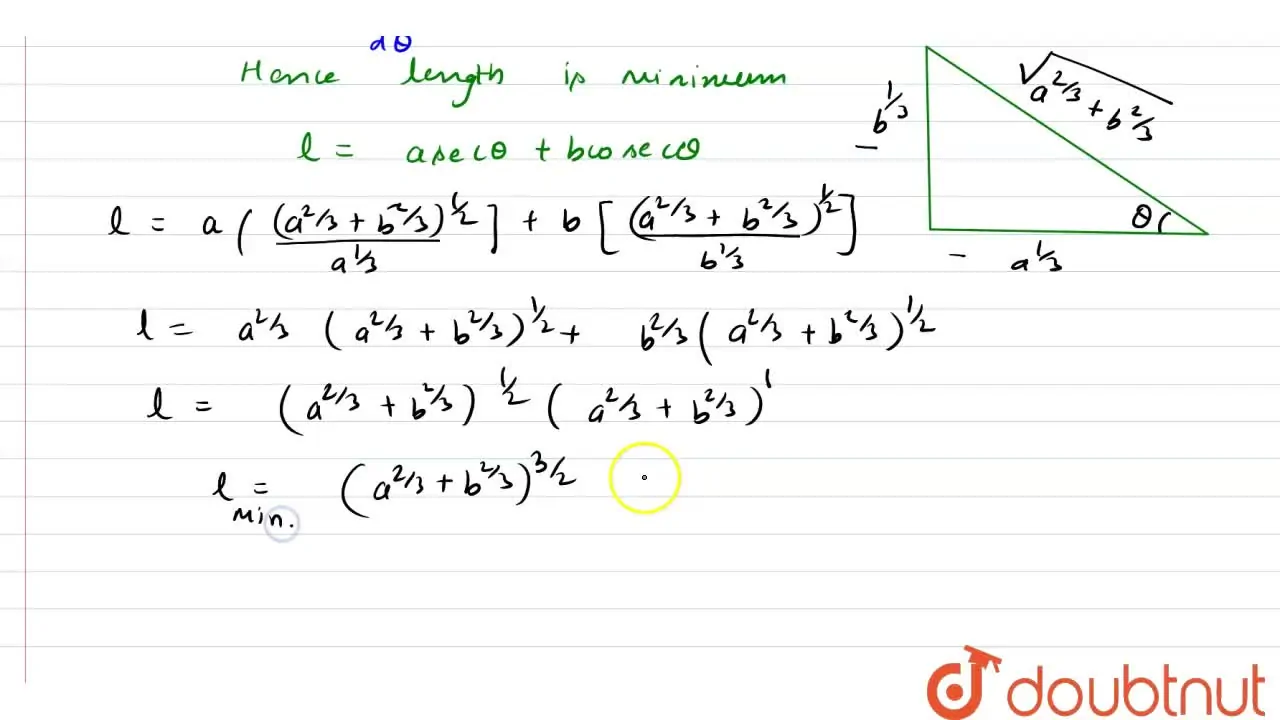A point on the hypotenuse of a triangle is at distance a and b from the sides of the triangle. Show that the maximum length of the hypotenuse is (a23+b23)32 .
Let P be a point on the hypotenuse AC of right △ABC such that
PL ⊥ AB=a PM⊥BC=b
Let ∠APL=∠ACB=θ AP=asecθ and PC=bcosecθ
Let l be the length of the hypotenuse, then l=AP+PC
⇒a secθ+b cosecθ, 0<θ<π2
Now differentiate l with respect to θ, we get
dldθ=asecθ.tanθ−bcosecθ.cotθ
For maxima and minima dldθ=0
⇒asecθ.tanθ=bcosecθ.cotθ
⇒ba=tan3θ
⇒tanθ=ba13
d2ldθ2=asecθ(sec2θ+tan2θ)+bcosecθ×bcosecθ+cot2θ
Since 0<θ<π2 so all t ratios of θ are positive.
Also a>0 and b<0.
∴d2ldθ2 is positive
⇒ l is least when tanθ=ba13
Least value of l =asecθ+bcosecθ
=(a23+b23)32
Hence Proved.
Related Playlists
- BOOK - NCERT ENGLISHCHAPTER - APPLICATION OF DERIVATIVESEXERCISE - EXERCISE 6.49videos
APPLICATION OF DERIVATIVES
- BOOK - NCERT ENGLISHCHAPTER - APPLICATION OF DERIVATIVESEXERCISE - EXERCISE 6.529videos
APPLICATION OF DERIVATIVES
- BOOK - NCERT ENGLISHCHAPTER - APPLICATION OF INTEGRALSEXERCISE - EXERCISE 8.27videos
APPLICATION OF INTEGRALS
Similar Questions
A point on the hypotenuse of a right triangle is at distances a and b from the sides of the triangle. Show that the minimum length of the hypotenuse is (a23+b23)32
View SolutionThe hypotenuse of a triangle is 2.5 cm. If one of the sides is 1.5 cm. find the length of the other side.
View SolutionProve that the mid-point of the hypotenuse of a right triangle is equidistant from its vertices.
View SolutionAn isosceles right triangle has area 8 cm2. The length of its hypotenuse is
View SolutionIf A be the area of a right triangle and b one of the sides containing the right angle, prove that the length of the altitude on the hypotenuse is 2AB√b4+4A2
View SolutionThe hypotenuse of a right triangle is 25 cm. The difference between the lengths of the other two sides of the triangle is 5 cm. Find the lengths of these sides.
View SolutionProve that (2, −2), (−2, 1) and (5, 2) are the vertices of a right angled triangle. Find the area of the triangle and the length of the hypotenuse.
View SolutionThe hypotenuse of a right triangle is 13cm long. If one of the remaining two sides is of length 5cm, find the length of another side.
View SolutionThe lengths of the sides of a triangle are in the ratio 2:3:4. If the perimeter of the triangle is 63 cm, find the lengths of the sides of the triangle.
View SolutionThe hypotenuse of a right triangle is 6 m more than the twice of the shortest side. If the third side is 2 m less than the hypotenuse, find the sides of the triangle.
View Solution


